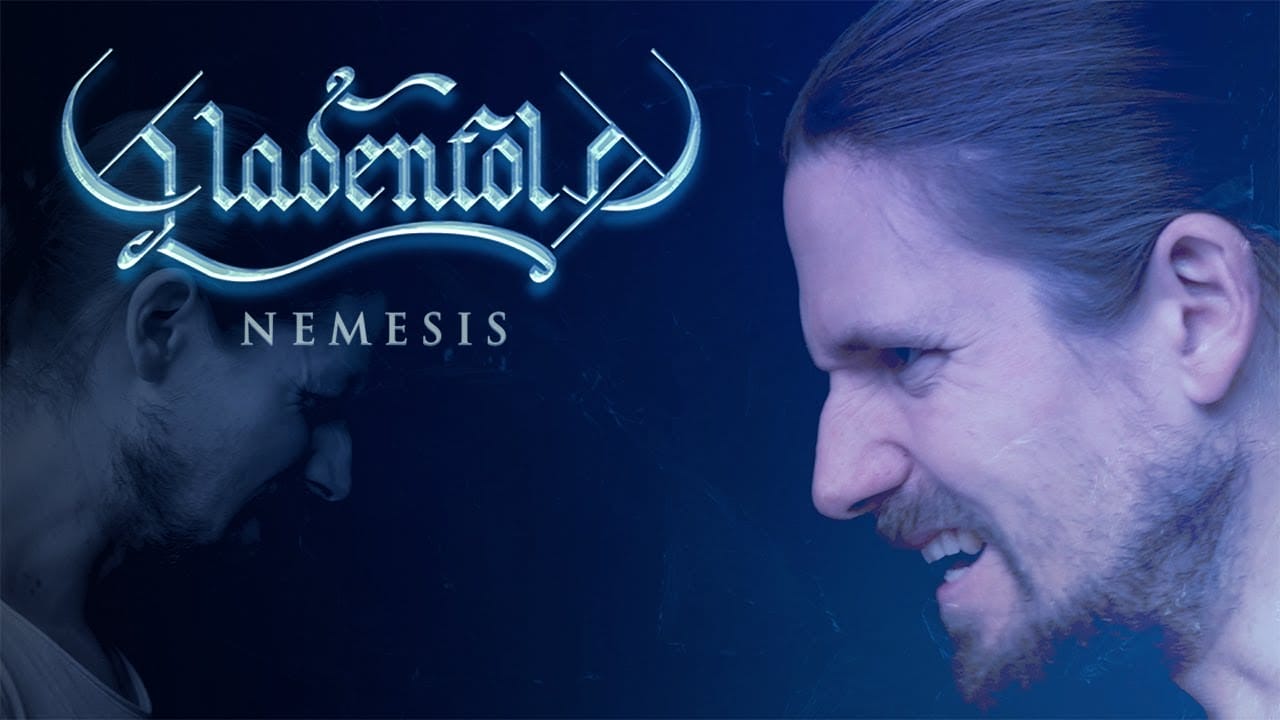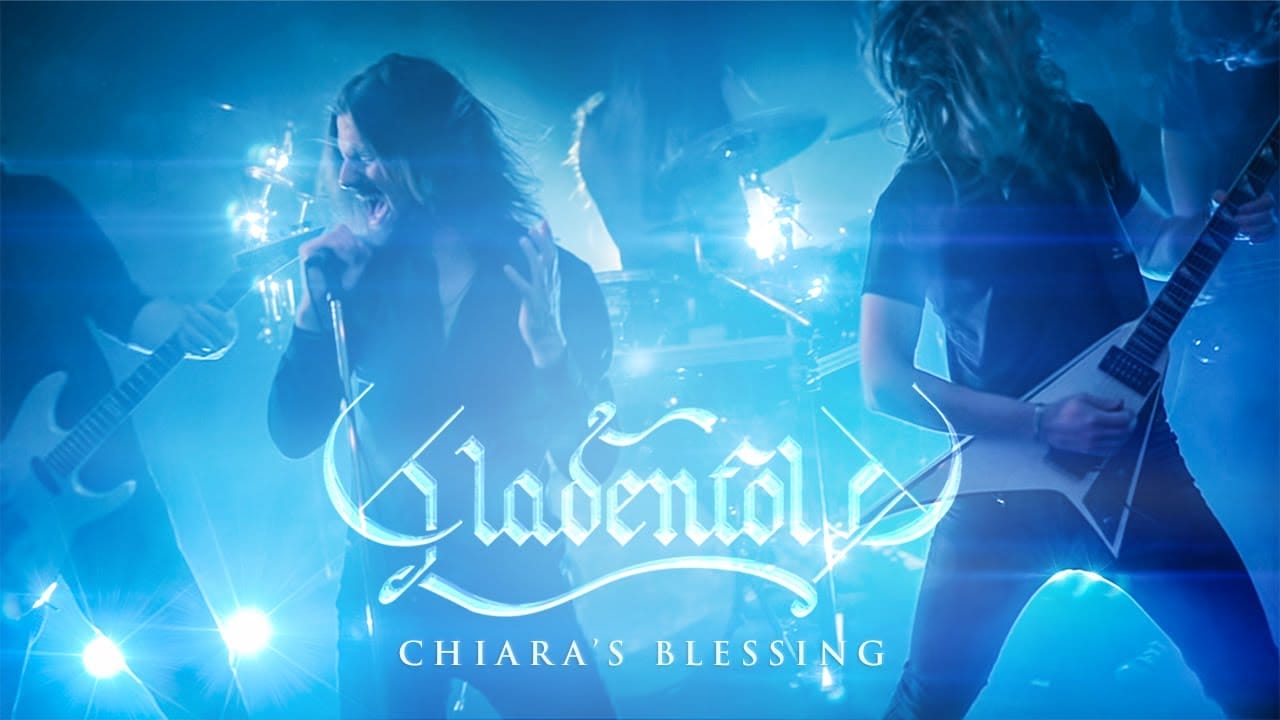„Epic Melodic Death Power“ – that’s how GLADENFOLD describe their genre mix. The finnish guys have creativity and ideas without end and manage on „Nemesis“ to pack them into varied songs with a red thread. We talk to singer Esko Itälä, drummer Lauri Itälä and guitarist Toke Gerdts about the mix of styles, emotional lyrics and epic musicals.

 Hello, thank you for taking time to do this interview. How are you the days?
Hello, thank you for taking time to do this interview. How are you the days?
Lauri: Thank you for asking, I’m doing fine. My day job and the coming release of “Nemesis” is really keeping me and the other boys busy. But in a good way. Working with all the promotional material is quite pleasant work.
GLADENFOLD were already founded in 2003 but might still be a blank sheet for most of our readers. Can you tell us at the beginning about your beginnings?
Lauri: Well, that is something I could go on for ages. (laughs) First of all in the very beginning we were just a bunch of teens, I was 14 or 15 when we started with GLADENFOLD and others not much older, with not that much experience in music. For example, I hadn’t played the drums before, so I had to start from scratch and that took some time to even learn the basic stuff. (laughs) Also in the beginning playing in a band was just a hobby and it took some years before we realized that it maybe could be something more than just a “hobby”. And then of course there have also been so many changes in the line-up that I can’t even count them all :) And now Esko and myself are the only ones from the early days. I think it was with the release of our latest demo “Tales From Worlds Afar” that we took our first big step towards being a noteworthy band and also found the GLADENFOLD style with our music. Before that it had been a variety of different styles and genres. But although we have become a more serious and more known band which of course is our goal, it is important for us to still maintain that “this is a hobby” mindset in a way, for that makes playing more enjoyable and fun.
How do you think you have developed since your second album „When Gods Descend“ and did Corona have any influence on the production and the final sound of „Nemesis“?
 Toke: The main way, in which we have developed as a band, is the willingness to compromise in order to serve the song. The band has very disparate musical backgrounds and influences, and, as a result, we have an enormous number of ideas for each song, which is very evident on “When Gods Descend”. For “Nemesis”, we wanted a more streamlined approach, where there is one, or perhaps a few, main ideas in each section, and everything else around it then supports those main ideas. In terms of the pandemic, it primarily affected how we worked; the majority of the album was written and recorded in our respective home studios, by bouncing ideas back and forth via online messages. One could say that this way of working also affected the sound, but these days, you can achieve so much in even a budget-friendly home studio, that it was hardly a compromise, and the drums were still recorded live in a studio. Since this new album is also much darker in sound and visuals, compared to “When Gods Descend”, it would be reasonable to assume that this was affected by the pandemic, but almost, if not all, of the songs were written pre-pandemic, so it is not related in that sense.
Toke: The main way, in which we have developed as a band, is the willingness to compromise in order to serve the song. The band has very disparate musical backgrounds and influences, and, as a result, we have an enormous number of ideas for each song, which is very evident on “When Gods Descend”. For “Nemesis”, we wanted a more streamlined approach, where there is one, or perhaps a few, main ideas in each section, and everything else around it then supports those main ideas. In terms of the pandemic, it primarily affected how we worked; the majority of the album was written and recorded in our respective home studios, by bouncing ideas back and forth via online messages. One could say that this way of working also affected the sound, but these days, you can achieve so much in even a budget-friendly home studio, that it was hardly a compromise, and the drums were still recorded live in a studio. Since this new album is also much darker in sound and visuals, compared to “When Gods Descend”, it would be reasonable to assume that this was affected by the pandemic, but almost, if not all, of the songs were written pre-pandemic, so it is not related in that sense.
Your sound and mix of melodic death, symphonic and power metal sounds pretty unique. How would you describe and classify your sound yourself?
Toke: We might still have some stickers left that read, “GLADENFOLD – Epic Melodic Death Power”, which is more-or-less trying to encompass the mix of genres you describe. The combination of melodic death metal and power metal is our current framework for GLADENFOLD, and the symphonic elements are taking the backseat. The problem with the symphonic parts is that the live shows often become heavily reliant on backing tracks, which we have come to find uninspiring, and it also ended up taking away a lot of attention from our keyboardist, who we really wanted to showcase on this new album. Other than that, each band member’s current influences also seep into the songs. For this album, examples of these sorts of references, without naming any specific artists, would be black metal, synth pop and shoegaze.
If GLADENFOLD is a perfect symbiosis of death and power metal, what two bands from these genres would have been blended?
Lauri: Well, if Dark Tranquility and Freedom Call had a baby it could be GLADENFOLD. (laughs) But of course there is a huge variety of different bands from both genres that have influenced us throughout the years that it is very hard to name just two.
You have found a balance between melodic death and power metal that I have rarely heard in such a convincing way. Do you pay attention to a perfect mixture of genres in songwriting?
Toke: Like all artists that have a lot of layers in their music, we pay very close attention to the blend of different sonic elements and textures that we use, but not so much the balance between power metal and melodic death metal. It always feels fairly clear which type of vocals or guitar riff a certain part calls for, as an example.
I think your music sounds very Finnish – what do you say about it and what would you say characterizes Finnish metal and makes it special?
Toke: The most frequently occurring word, when talking about what characterizes Finnish music, is probably „melancholy“, and this rings even truer for Finnish metal. GLADENFOLD certainly embodies this aspect as well, both musically and lyrically, but we also intentionally tapped into the Finnishness on this album. Me and our keyboardist, Paavali, referenced several keyboards sounds that came included in 90s Korg and Roland synths/ROMplers, and were used HEAVILY on late 90s and early 00s Finnish rock and metal albums – I think everyone, who has listened, knows the type of sounds, I am thinking of.
Listening to „Nemesis“, bands like Sonata Arctica, Kamelot, Falconer, Children Of Bodom and Wintersun came to my mind. Which bands would you call your biggest influences and are the mentioned bands also sources of inspiration?
Toke: I, myself, am not particularly familiar with Falconer, but all the other bands have ABSOLUTELY been game changers for all of us, and we constantly mention and reference them, to this day. My personal biggest influences are the artists that are not too concerned with fitting the mold of existing genres, manage to incorporate their diverse influences into something original, enabling new ways of playing and thinking about music, which could be said about Frank Zappa, David Bowie, Devin Townsend and The 1975, among MANY others.
The album is called „Nemesis“ – who is the titular nemesis and who or what is your personal nemesis in your life?
Esko: We all are, or at least we have the potential to become that. It’s about circumstances and coping skills we possess how we end up seeing ourselves in the mirror at the end of the day. In this album, Nemesis is more like a phenomenon of self-reflection.
Aside from bands and music, what inspires you in songwriting and writing lyrics?
Ekso: In a way, I write about my own thoughts and doubts, fears and desires, things I have lived through or witnessed. I try to come up with a story in which I blend these topics of my own life. Topics that are usually involved in the lyrics would be human relations, nature, morality, humanity, and things like that. Musically I get inspired on an emotional level and I kind of compose how I feel. So mostly I create heroic and uplifting themes but sometimes there are just darker moments in life and Nemesis is a result of that. I guess the next album won’t be that dark.
Can you tell me about the lyrical topics on the album? Do the songs hang together thematically, or do they stand more for themselves?
Esko: One can find many different meanings or themes on this album. To me, the main theme is psychological. It’s like a battle of good and evil in ourselves. We are all capable of choosing both ways. But what is it that makes us choose evil above good or is it even ours to choose? Can we fix our wrong decisions or are we bound to them?
You can follow this theme when listening Nemesis. But instead of starting from the beginning you might have to start from the fifth song, “Saraste”.
„Nemesis“ is an insanely diverse and multi-layered album. As a Blind Guardian fan, I especially like „Saraste“, which creates a very special, devotional campfire atmosphere with its acoustic guitars. What is the song about and what makes it so emotional?
Esko: It was originally composed as a love letter to my lovely wife Sara so hopefully emotions come from there. I guess it was picked to the album because of the delicate emotional presence in it. I feel like it has a major role in this album both story wise and music wise.
Especially the title track is such a dramatic, complex track that I had to think of a stage play or a theater performance more often. I think the track tells an exciting story instrumentally and through the epic choirs. Is GLADENFOLD’s goal to create tension and drama with the songs and tell stories?
Toke: In the words of the mix engineer, when he first pulled up the title track: “It’s like a musical!” Yes, we love to tell stories with our music. A lot of this of course happens in the lyric- and songwriting process, but production also plays a huge part. We love having many different sonic environments within a single track, as well as experimenting with different types of vocal staging. Instrumentally, this is realized by tailoring the drum mix, guitar, and bass sounds for each part, with some sections being mangled and distorted beyond recognition, while others remain fairly organic. For the vocals, we wanted to have this dryer, more intimate lead vocal, surrounded by maddening, distorted whispers, which is then contrasted by the aggressive growl vocals and the huge choir, drenched in reverb. What kind of meaning these aesthetic choices amount to, combined with the song, the lyrics, and the visuals, is up to the listener; I think it allows for many, equally valid interpretations.
Which of the tracks on „Nemesis“ are your personal favorites?
Lauri: I really like the title song “Nemesis” because it has so many different layers, it is one of the most aggressive songs on this album and it is super fun to play live. The other one is “Solitude’s Bane” because at the demo stage it wasn’t that convincing but turned out so amazingly good.
Let’s conclude with our traditional brainstorming. What comes to your mind first when you read the following words?
Current favorite album:
Lauri: Bloodred Hourglass – Your Highness.
Toke: Bleachers – Take the Sadness out of Saturday Night.
Ukraine: Respect.
Best Movie-/Series-/Book-Universe:
Lauri: Star Wars.
Will Smith:
Lauri: More memes. (laughs)
Video games:
Lauri: “Heroes of Might and Magic 3”.
Collecting:
Lauri: Useless stuff unintentionally. (laughs)
Toke: Guitar pedals!
Something that makes every bad day better:
Lauri: Sauna with a beer or two.
GLADENFOLD in ten years:
Lauri: Hopefully still active.
Thank you once again for your time! The last words are all yours.
Lauri: Horns high and get your copy of “Nemesis” if you haven’t already. Hopefully we’ll see you at shows sometime soon.
Dieses Interview wurde per E-Mail geführt.
Zur besseren Lesbarkeit wurden Smilies ersetzt.



